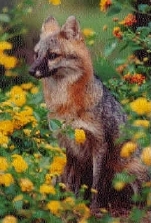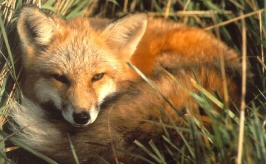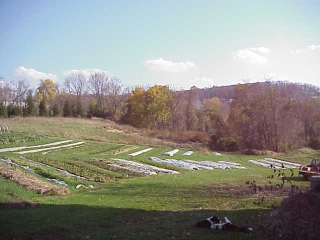 The Fox
By Dawn Lawless
With fox hunting being part of a strong tradition in Chester County, let's take a closer look at this animal. The fox is related to the dog, coyote and wolf. They are incredibly smart and have exceptionally sharp senses of sight, smell and hearing.
Both the red fox and gray fox can be found in Pennsylvania. They are similar in size, both looking heavier than they really are due to their thick fur. Adults weigh only about 7-13 pounds. The red fox can have many color variations, but the distinguishing characteristic is the white tail tip. Both foxes are quick runners and capable swimmers, but only the gray fox can climb trees.

Gray Fox |
Foxes are opportunistic eaters and will consume almost anything, including road kill. They will eat mice, rats, rabbits, woodchucks, opossums, porcupines, cats, chickens, insects, squirrels, birds, eggs, fruits and grasses. They will also stash uneaten food in loose earth.
Foxes mate in February and the pups are born in dens about 51 days later for the red foxes and 63 days later for the grays. Their dens usually have several entrances. Pups don't venture out of the den for a month, and then they are weaned off of milk by being fed solid food provided by both parents. You may see the young leaving the den in mid-July or August to forage with their parents. In the fall the family breaks apart and the young are sexually mature by their first winter.

Red Fox |
In the winter red foxes prefer to sleep in the open, using their bushy tail to cover their noses, while the gray fox may hide in a hole for several days during bad weather. The red fox generally prefers habitat such as Maysie's Farm that has farm areas, wooded areas and streams, while the gray fox tends to be located in heavy woods, swampy lands, and mountains.
Foxes suffer a high mortality rate, but when their populations get too large, both species tend to be stricken hard with parasites and diseases. Since red foxes seem less afraid of people than grays, they are the ones you are most likely to see.
Conservation Corner
By Amy Bruckner
Land Preservation — Conservation Easements 102/No. 2 of 3
In the last newsletter I mentioned that the current tax law allows a property owner a charitable deduction of up to 30% of their income over a 6-year period for a Conservation Easement. The Senate recently passed legislation that will increase the charitable deductions for Conservation Easements and extend the carry over period, making the benefits more attractive in the future. However, the legislation must make its way through Congress. This is the major charities Bill H.R. 7, and could increase deductions up to 50% of income over a period to 16 years. This could have a major impact on land preservation as it would be more attractive to farmers and landowners with lower income to donate conservation easements on their land.
Passage of Bill H.R. 7 would enable more landowners to take land preservation into their own hands, resulting in less reliance on public funding to foot the bill. So, why is this so attractive when developers are knocking on doors offering fantastic prices? When landowners focus on the sale prices offered them by developers who want to subdivide their land, they don't take into account the tax consequences and timing of payment. It can take up to 5 years to get the financing and approval for the subdivision and the necessary permits. Developers often require that these conditions be met before payment is made. Once they get the money from the sale, the landowner has to pay sales commission, capital gains tax and legal fees, and many times it is a real (unpleasant) surprise how much the net return on the land is.
While donating conservations easements or even donating the land itself may not result in the returns that can be attained by full out development, it can still be an attractive option depending on the landowner's situation. For example, if a landowner wants a property to stay within the family, donation of a conservation easement while the landowner is still alive can help by taking the immense tax burdens off those inheriting the land. So often, children are forced to sell their parent's land to developers because they cannot afford to pay the taxes.
Stay tuned for more discussion of options for property owners.
|

Maysie at the Annual Party |
|
Don't Forget...
It's time to get your Maysie's Farm membership form in!
And please spread the word to family and friends!
Call Sam at 610-458-8129 for more information. |

Church Field late in season |
Family Gardening Workshop
Maysie's Farm is offering a "Growing Families, Growing Gardens" workshop on Sunday, May 2, 2004 from 1pm to 5pm. Parents and children will work together to learn how to custom design, implement and maintain a backyard garden. Participants will take home compost and seeds or seedlings to start a garden. Space is limited to 15 families. Cost is $30 per family ($25 for Maysie's Farm shareholders). For more information contact Sam at 610-458-8129.
|




